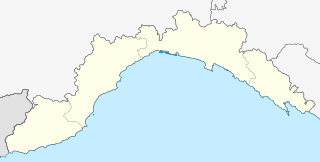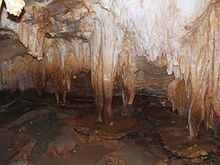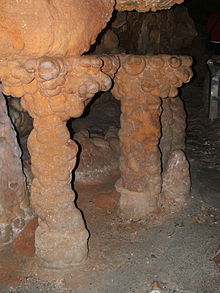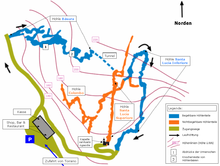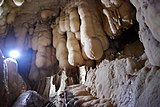Grotte di Toirano
| Grotte di Toirano
|
||
|---|---|---|
| Location: | Toirano , Liguria , Italy | |
|
Geographic location: |
44 ° 8 '9.6 " N , 8 ° 12' 3.6" E | |
|
|
||
| Type: | Stalactite cave | |
| Discovery: | 1890 | |
| Show cave since: | 1953 | |
| Lighting: | electric | |
| Overall length: | approx. 1700 m | |
| Length of the show cave area: |
1300 m | |
| Particularities: | Cave network | |
| Website: | www.toiranogrotte.it (only Italian) | |
The cave system Grotte di Toirano is located above the town of Toirano , Province of Savona , in the Liguria region in Italy . It is located at the end of the Vallone del Vero , the Valley of Truth , seven kilometers from the Mediterranean Sea between the towns of Albenga and Finale Ligure on the Riviera di Ponente . In addition to the three grottos to be visited, around 70 other stalactite caves should be located in the region.
history
The caves are located in the foothills of a limestone massif made of gray dolomite .
The cave entrances were buried for a long time, it was not until 1890 that Nicolò Marelli explored the entrance area of the Grotta della Bàsura , the “witch's cave”. From 1950 the Bàsura grotto was uncovered by speleologists and developed as a show cave. It has been possible to visit the cave since 1953. It has been connected to the Grotta di San Lucia Inferiore since the mid-1960s via a connecting tunnel about 120 meters long, carved into the stone . In the Grotta della Bàsura it is possible to see a large number of stalactites and stalagmites that normally one would not be able to see at all: A room in the Antro die Cibele that was completely filled with water when it was discovered was emptied and can now be viewed "dry". In Italian these large spherical deposits are called “ concrezioni mamellonari ”, large and wide yellowish structures, natural wonders that only arise under water over the course of thousands of years.
The Il Tanone , the last piece of the cave Lucia once was, shelter and is used for events today.
About 14,000 years ago some human families ( Homo sapiens ) were in the cave . Traces of their Stone Age life have been found in the front areas : several footprints, several knee prints and fingerprints. There are also clay balls that have been thrown on the wall. Clay balls and traces on the wall can still be seen today. More recent and detailed Italian-South African-Argentine investigations from 2016 found 180 footprints of a group of human ancestors that came from two children (estimated 3 and 6 years old), one adolescent (8-11 years old) and two adults. Only the larger footprint of the heavier adult can be attributed to a man. Those of the other four individuals do not allow any gender-specific information about the footprints. The results of the investigation showed that the group went deep into the cave to the Sala dei Misteri mostly along one side of the wall and was equipped with pine flares made of Scots pine wood. Especially in the rear area of La grotta della Bàsura between the sections of the Bear Cemetery and the Hall of Mysteries , the history of the visit by the Stone Age people was cleared up. The nested footprints now serve as evidence that the individuals as a group visited the cave at the same time. The kneeling or sliding movement in the narrow cave area was documented for the first time. Traces of canine animals found in the Corridoio delle Impronte near the human footprints suggest that canine animals have already been domesticated.
In addition, cave bears (Ursus spelaeus) lived in the cave over 20,000 years ago, and remains of bones can be admired. What is amazing is that the bones were found far inside the cave, where there was absolute darkness. It is assumed that the bones were washed far into the interior of the cavity during flooding, which results from the bone mixtures and the arrangement of the bone fragments.
Finds show that the caves were also used as burial places for the Romans in later times .
construction
La grotta della Bàsura (grotta della strega)
Opened in 1953:
- Sala Morelli (access)
- Il salotto
- Corridoio delle Impronte (Corridor of the footprints of primitive man)
- Il Laghetto
- Cimitero degli Orsi (Bear Cemetery)
- Sala dei Misteri (Room of the Mysteries )
- Antro di Cibele
- Tunnel di collegamento (opened in 1967)
Grotta di Santa Lucia Inferiore
Opened in 1966, direction from the end to the exit as the visitor direction:
- I Cristalli
- Pantheon
- Sala dei livelli (dei capitelli)
- Il Tanone (exit)
Grotta di Santa Lucia Superiore
The grotto has been known since the Middle Ages. Shortly after the exit of the Inferiore cave, on the path leading down to the exit, a short path branches off to the right up the steep slope to an old chapel, called santuario rupestre , which can be visited. The chapel is a late medieval pilgrimage site from the 15th century. The chapel was partly carved directly into the stone and an allegedly miraculous spring rises from it, the healing effect of which is attributed to Saint Lucia for eye diseases . To the left of the staircase next to the altar is a narrow access to another cave - the approx. 240 m long Grotta di San Lucia Superiore.
La grotta del Colombo
Another 50 meters above Santa Lucia Superiore is the Grotta del Colombo , which can only be used for scientific purposes. Bone fragments found there are said to be over 300,000 years old and to be assigned to Homo heidelbergensis .
- Grotte di Toirano
Aragonite "stars" and spherical sintering
Visitor information
Well over 100,000 tourists visit the caves every year. The caves can be visited on guided tours. Most of the time, foreign language tours are also offered in German and English. Photos can be taken in the caves, except in the areas of prehistoric man's prints and animal bone fragments. The tours offered last between one and one and a half hours. The temperature in the cave is around 16 ° C.
In the village there is the Museum Museo Etnografico della Val Varatella , in which finds from the caves are also shown.
literature
- Andrea Gobetti: L'Italia in Grotta. Gremese Editore, Rome 1991, ISBN 88-7605-609-2 .
- Società Speleologico Italiana: le nostre grotte. guida speleologica ligure. A cura di Roberto Bixio. Sagep Editrice, Genoa 1987, ISBN 88-7058-234-5 .
- Chiesa Roberto, Castellino Stefania: La Grotta Santuario di Santa Lucia. In: Speleologia. No. 40, 1999, ISSN 0394-9761 , pp. 45-52.
Web links
- English language website of the Italian website of the cave museum at www.toiranogrotte.it
- www.lochstein.de/Toirano: Information and pictures on a private website
- Grotte di Toirano in the Liguria network www.ligurien-netz.de
- Grotte di Toirano - Italy has famous stalactite caves on the website www.riviera-dei-fiori.de
Individual evidence
- ↑ The numbers fluctuate in the literature with estimates of 50 to 150 caverns, caves and cave systems.
- ↑ The latest investigations by the University of Pisa, Genoa and Witwatersrand date the finds between 12.310 and 12.370 BC. u. Z.
- ↑ Marco Romano et al .: A multidisciplinary approach to a unique Palaeolithic human ichnological record from Italy (Bàsura Cave) , May 14, 2019, Online: elifesciences.org ; doi: 10.7554 / eLife.45204 ; accessed on May 16, 2019

